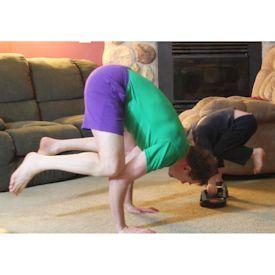"lifting fast"...why? Stronglifts5x5
Options
Replies
-
The easy way (for me) to visualize distance covered is to do a graph with time on the X and velocity on the Y axis. At 0.5 m/s/s you'd draw a line from 0,0 to 2,1 to show the velocity through time. This makes a triangle, the area of which is the distance traveled because you're summing the distance covered at each little vertical slice. If you draw it out, the triangle is half of a 1 * 2 rectangle, so the area is 1.
I actually loled at that part.Ok here's the math...
1 Newton is the amount of force needed to accelerate 1 kilogram at 1 meter per second per second.
Gravity is a constant 9.8 m/s/s, so a 1 kilogram weight would exert a downward force of 9.8 Newtons. 100 kg would exert 980 Newtons.
In order to hold an unsupported 100 kg weight up you'd need to exert 980 Newtons upward.
Let's take an example of someone doing an overhead press of 100 kg where the distance covered in a rep is 1 meter. (Yes they are really strong and have long arms, LOL.)
In order to do a 2 second rep (taking 2 seconds to go from bottom to top) they would accelerate the weight at about 0.5 m/s/s. Which would require 980 + (0.5 * 100) or 1030 Newtons.
In order to do a 1 second rep, they'd accelerate the weight at about 2 m/s/s, requiring 980 + (2 * 100) or 1180 Newtons.
The first lifter would have applied 2060 Newton seconds worth of energy to get the weight over his head. The second lifter would have expended 1180 Newton seconds to do it. (Is this where "power" is said to be greater for the slower rep?)
Since the second lifter can apply more force, he can lift a heavier weight at 0.5 m/s/s. This would be found by solving for 9.8w + 0.5w = 1180. Or 10.3w = 1180. So w=1180/10.3 = 114.56 kg.
Conclusion: the lifter who can push 100 kg in a 1 second rep can lift 114 kg for a 2 second rep by applying the same amount of force.
(This is assuming the second lifter has enough "endurance" to exert that amount of force for two whole seconds. But I find it hard to imagine anyone running out of steam THAT quickly.)
I quickly went through the math so anyone is welcome to double check/correct it.
Also, shouldn't that bolded 2 be a 1 leaving us with 1080?
If you need to travel 1 meter in 1 second, you need a triangle that is 1 second wide and 2 units tall in order to get an area of 1. So the acceleration would be 2 m/s/s. (Sorry, there's probably a "better" way to solve this but that's how I do it.)
So you're applying 200 Newtons beyond the force of gravity in order to lift at 2 m/s/s to get a 1 second rep. That's where the 1180 comes from.
They are both moving the weight 1 meter to complete a rep. One is doing 1030 for 2 seconds to move it 1 meter. The other is doing 1180 for 1 second to move it 1 meter. By "power" I meant force X time... probably used it wrong. The slower lifting person would end up burning more calories / expending more energy during his lift, is what I mean.And for the power comment, The second lifter is doing 1s lifts. So Power=Force*1m/1s where as the other would be (F*2=2060)*1m/2s=F*1m/1s since that guy only did half a meter right...so wouldn't the power be equal?0 -
A guy I know asked some of the best Russian powerlifters in the world when they incorporate speed training? (like the Westside method)
Answer: "we do everything as fast as possible"0 -
Training explosively has been a main staple of strength athletes' training for decades.0
-
thanks I kinda didn't think about it and saw half the time turn to 4 times the something else.
The easy way (for me) to visualize distance covered is to do a graph with time on the X and velocity on the Y axis. At 0.5 m/s/s you'd draw a line from 0,0 to 2,1 to show the velocity through time. This makes a triangle, the area of which is the distance traveled because you're summing the distance covered at each little vertical slice. If you draw it out, the triangle is half of a 1 * 2 rectangle, so the area is 1.
I actually loled at that part.Ok here's the math...
1 Newton is the amount of force needed to accelerate 1 kilogram at 1 meter per second per second.
Gravity is a constant 9.8 m/s/s, so a 1 kilogram weight would exert a downward force of 9.8 Newtons. 100 kg would exert 980 Newtons.
In order to hold an unsupported 100 kg weight up you'd need to exert 980 Newtons upward.
Let's take an example of someone doing an overhead press of 100 kg where the distance covered in a rep is 1 meter. (Yes they are really strong and have long arms, LOL.)
In order to do a 2 second rep (taking 2 seconds to go from bottom to top) they would accelerate the weight at about 0.5 m/s/s. Which would require 980 + (0.5 * 100) or 1030 Newtons.
In order to do a 1 second rep, they'd accelerate the weight at about 2 m/s/s, requiring 980 + (2 * 100) or 1180 Newtons.
The first lifter would have applied 2060 Newton seconds worth of energy to get the weight over his head. The second lifter would have expended 1180 Newton seconds to do it. (Is this where "power" is said to be greater for the slower rep?)
Since the second lifter can apply more force, he can lift a heavier weight at 0.5 m/s/s. This would be found by solving for 9.8w + 0.5w = 1180. Or 10.3w = 1180. So w=1180/10.3 = 114.56 kg.
Conclusion: the lifter who can push 100 kg in a 1 second rep can lift 114 kg for a 2 second rep by applying the same amount of force.
(This is assuming the second lifter has enough "endurance" to exert that amount of force for two whole seconds. But I find it hard to imagine anyone running out of steam THAT quickly.)
I quickly went through the math so anyone is welcome to double check/correct it.
Also, shouldn't that bolded 2 be a 1 leaving us with 1080?
If you need to travel 1 meter in 1 second, you need a triangle that is 1 second wide and 2 units tall in order to get an area of 1. So the acceleration would be 2 m/s/s. (Sorry, there's probably a "better" way to solve this but that's how I do it.)
So you're applying 200 Newtons beyond the force of gravity in order to lift at 2 m/s/s to get a 1 second rep. That's where the 1180 comes from.
They are both moving the weight 1 meter to complete a rep. One is doing 1030 for 2 seconds to move it 1 meter. The other is doing 1180 for 1 second to move it 1 meter. By "power" I meant force X time... probably used it wrong. The slower lifting person would end up burning more calories / expending more energy during his lift, is what I mean.And for the power comment, The second lifter is doing 1s lifts. So Power=Force*1m/1s where as the other would be (F*2=2060)*1m/2s=F*1m/1s since that guy only did half a meter right...so wouldn't the power be equal?
Power is Work over time....Work is what you just said power was (force times time)0 -
Agree with everyone who has said that speed is an integral part of strength training. I can't imagine a serious SC who wouldn't advocate it, nor I am I aware of any common protocols that don't prescribe it in high volume phases.0
-
speed is great yes but you need substantial weight to tear the muscle fibres , personally i have no clue about 5x5 , all i can say is that to build muscle WEIGHT is important , just as important as speed .slower movements actually focus more on the "contraction" and speed is more for "explosive power". leave no stone unturned and just get to the gym and lift with proper form and contract the muscle , eat and sleep ul build muscle and power.0
-
The other factor is time under tension for hypertrophy. For those doing 5x5 as a beginner program to learn the movements and retain LBM while cutting, I wouldn't worry about it.0
-
The other factor is time under tension for hypertrophy. For those doing 5x5 as a beginner program to learn the movements and retain LBM while cutting, I wouldn't worry about it.
x 2.
Working for explosive power and strength can be a great tool in the right context (P= F x V) but for average beginner?
Meh.0 -
The point of saying to "lift fast" is that it's teaching people to exert force on the bar.
Yes a max lift will be slow, but if you're exerting more force it's going to move faster.
That's why guys at westside barbell use the dynamic effort method. A strong and fast lifter is going to lift more than just a strong lifter. You should never be doing a lift slowly.0 -
I would waist away if I did a cutThe other factor is time under tension for hypertrophy. For those doing 5x5 as a beginner program to learn the movements and retain LBM while cutting, I wouldn't worry about it. I'm just curious george 0
I'm just curious george 0
Categories
- All Categories
- 1.4M Health, Wellness and Goals
- 392.1K Introduce Yourself
- 43.6K Getting Started
- 259.9K Health and Weight Loss
- 175.7K Food and Nutrition
- 47.4K Recipes
- 232.3K Fitness and Exercise
- 403 Sleep, Mindfulness and Overall Wellness
- 6.4K Goal: Maintaining Weight
- 8.5K Goal: Gaining Weight and Body Building
- 152.8K Motivation and Support
- 7.9K Challenges
- 1.3K Debate Club
- 96.3K Chit-Chat
- 2.5K Fun and Games
- 3.4K MyFitnessPal Information
- 23 News and Announcements
- 999 Feature Suggestions and Ideas
- 2.4K MyFitnessPal Tech Support Questions






